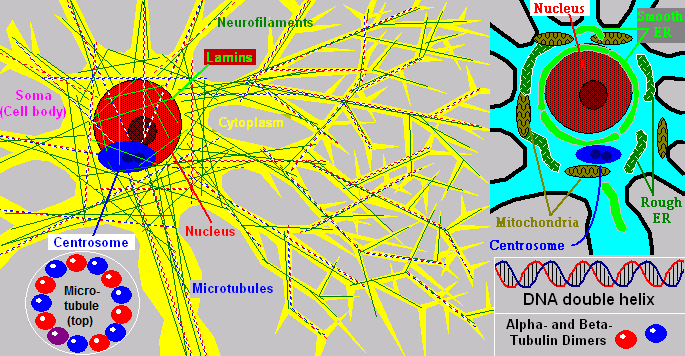31 Oct Modeling Biological Systems
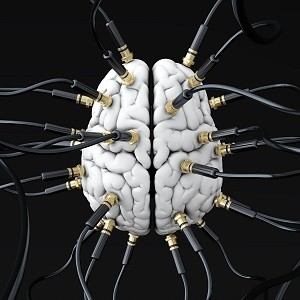 Possible Mechanisms of Learning, Memory and Cognition
Possible Mechanisms of Learning, Memory and Cognition
In the first section of this blog, I talked about the brain, as a whole, to establish a framework for the discussion of natural intelligence. In this section, I have delved into the inner workings of neurons, themselves to ensure we understand how complex they are, and where we might look for clues on the seat of intelligence in the brain. Theories about possible cybernetic roles for neurons or their parts should show a composition, structure and organization that could support information-processing functions. The composition requirement means that candidates must have parts or attributes that can represent and transmit information.
The structure and organization requirements mean that the candidates’ parts must be in the information chain, not buried in a component or insulated from exposure to the rest of the “circuit”. Furthermore, the parts must be located where they can perform proposed functions. Brain cells, or neurons, meet all these requirements.
| Understanding Context Cross-Reference |
|---|
| Click on these Links to other posts and glossary/bibliography references |
|
|
|
| Prior Post | Next Post |
| Modeling Neural Interconnections | Neural Networks – Section 3 Intro |
| Definitions | References |
| neuron cytoskeleton | Linck 1989 |
| cybernetic organelles DNA | Kuffler 1984 |
| Symbolic logic intelligence | Pickover 1990 |
We know that the medium of intercellular information transmission is electrochemical. We know that there are intracellular components (such as the cytoskeleton) that are capable of transducing electrical potential, catalyzing chemical changes, and altering their states. Before we can assume that cells are able to represent an information value, we should examine possible mechanisms that can functionally support representation, access, and modification of information.
| Composition | What parts do neurons have that can represent data? |
| Structure | Are the parts of neurons in the brain circuitry or adjacent to it? |
| Organization | Are the parts located in the right places in the circuit to perform information storage? |
Cybernetic Components
The components of neurons (some shown in the illustration) have specialized functions which were described throughout this section. We know that synaptic vesicles support cognition by bringing chemicals, synthesized in the soma, to synapses where they enable E/I transmission. How, though, might we factor the components of neurons into the cybernetic equation?
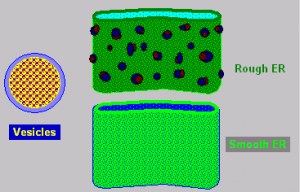 Smooth and rough endoplasmic reticulum could fit the structure requirements. In fact, some have envisioned the organization of ribosomes in rough ER as having some information content. Perhaps smooth ER could then be considered empty memory cells or OFF valued gates. No explanation of how ER can act as gates has emerged, however, so this theory is weak.
Smooth and rough endoplasmic reticulum could fit the structure requirements. In fact, some have envisioned the organization of ribosomes in rough ER as having some information content. Perhaps smooth ER could then be considered empty memory cells or OFF valued gates. No explanation of how ER can act as gates has emerged, however, so this theory is weak.
Mitochondria seem to be specialized for metabolism. While their organization in the cell may fit the model, their structure and composition are less suitable for cybernetic functions. Centrosomes participate in cell division, and DNA enables differentiation, but there is no persuasive evidence that either directly supports cognition. The nucleus may play a cybernetic role, but its structure gives no obvious clues what that might be.
More Components
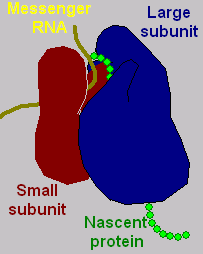 Ribosomes could also perform cybernetic functions related to cognition. They store information that can be accessed and used in maintenance and growth functions. The involvement of ribosomes in maintenance and growth processes, along with their location in the soma, seem to make them less likely candidates for data-processing functions of cognition. DNA in chromosomes also falls into this category.
Ribosomes could also perform cybernetic functions related to cognition. They store information that can be accessed and used in maintenance and growth functions. The involvement of ribosomes in maintenance and growth processes, along with their location in the soma, seem to make them less likely candidates for data-processing functions of cognition. DNA in chromosomes also falls into this category.
Cytoskeletal components, on the other hand, seem to possess a balance of composition, structure, and organization that qualifies them for cybernetic roles. Their electric conductivity and polarity as well as their position in cells, close to and between I/O channels, make them the prime candidates. Furthermore, their known role in neurons is providing structural support to the data processing function of the neural network (i.e. maintaining the links), making them seem even more attractive.
Microtubules
If microtubules (MT) played a major cybernetic role, how would they do it? As stated earlier, the structure of MT is a lattice of tubulin dimers that can be altered into as many as 17 different isoforms, each of which has an impact on the component’s ability to transduce current. If each tubulin dimer in an MT could store the equivalent of one binary bit of information, then each protofilament would be like a large data register and each MT would be like a high-capacity Erasable Programmable Read-Only Memory (EPROM).
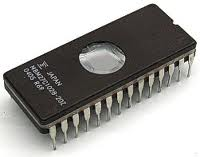 Why EPROM? Read-Only memory is more persistent than Random Access Memory (RAM), and human memory is persistent. EPROMs are slower to write and erase than RAM, as is human memory.
Why EPROM? Read-Only memory is more persistent than Random Access Memory (RAM), and human memory is persistent. EPROMs are slower to write and erase than RAM, as is human memory.
In this scenario, each neuron could hold enough information for a complex program. If each dimer holds, say, one of ten different states, each representing some information value, then the information-storage capacity of a neuron would be an order of magnitude greater. Thus, the notion of a gnostic cell, which will be described in the following section, becomes plausible.
Capacity of MT
Speaking conservatively, if each protofilament represented a single binary or analog bit, then a single MT could hold 12 (or 13) bits, and a single neuron could hold the equivalent of many bytes of data. Treating the synapses as logic gates and the microtubules as registers makes neurons self-contained processors with all the information necessary to encode, store, decode and deliver data in the form of patterns of ON and OFF or analog bits.
| Click below to look in each Understanding Context section |
|---|
| Intro | Context | 1 | Brains | 2 | Neurons | 3 | Neural Networks |
| 4 | Perception and Cognition | 5 | Fuzzy Logic | 6 | Language and Dialog | 7 | Cybernetic Models |
| 8 | Apps and Processes | 9 | The End of Code | Glossary | Bibliography |





